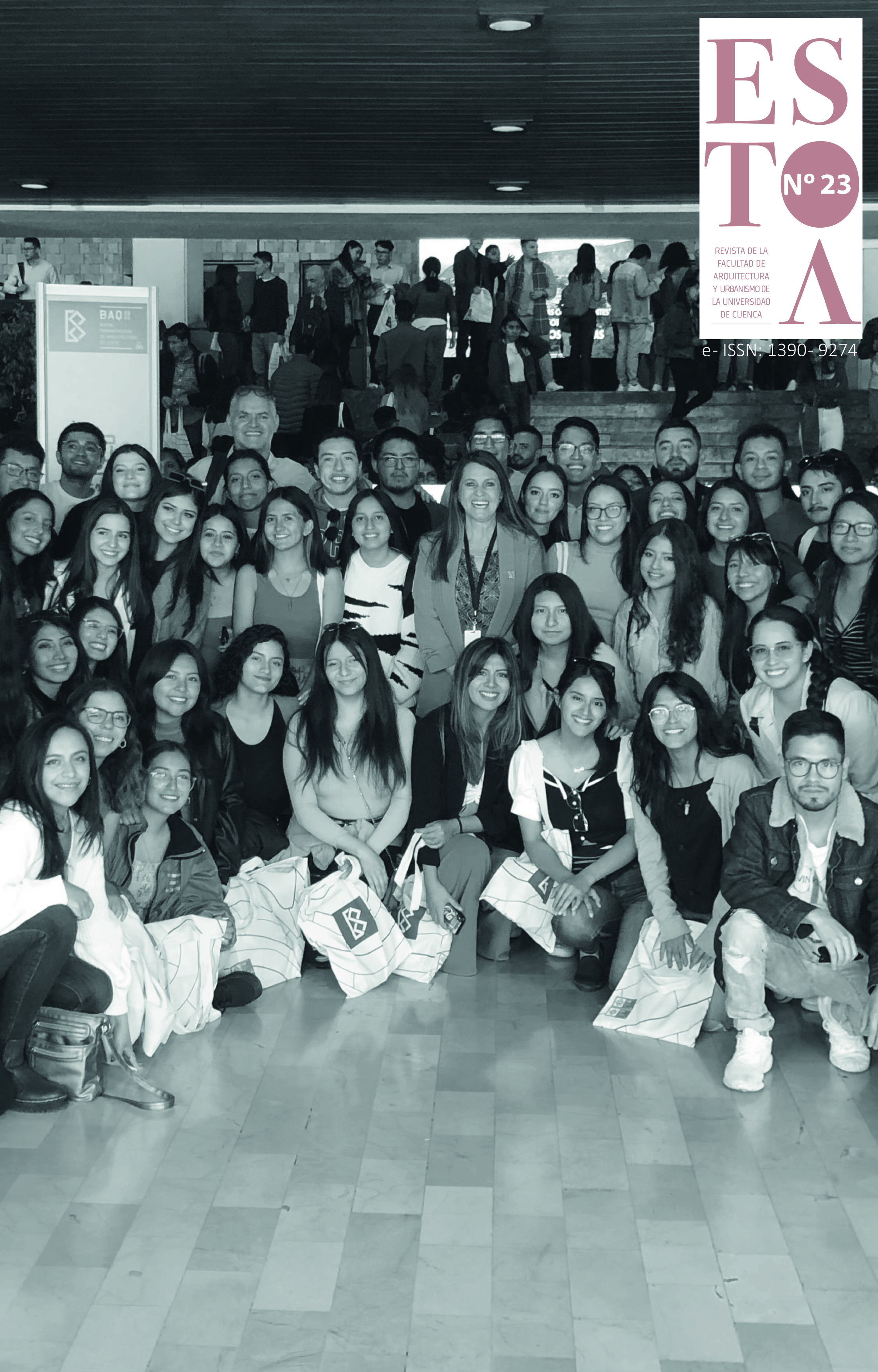Gender and daily mobility in a university community
DOI:
https://doi.org/10.18537/est.v012.n023.a02Keywords:
gender, daily mobility, women, sustainable transportation, universityAbstract
The city is not neutral, the right to it, its use and enjoyment by the subjects are conditioned, among other issues, by gender. In the case of women, their daily mobility decisions depend, to a large extent, on personal safety and the role of care. To reflect and delve into the subject, university community in Cuenca-Ecuador was taken as a case study. Two instruments were applied: survey and semi-structured interviews to teachers, administrative staff and students of the institution. The main results indicate that there are differences in daily mobility conditioned by gender. Studies like this warn about factors that inhibit sustainable mobility and contribute to understanding the phenomenon in intermediate Latin American cities.
Downloads
References
Abasahl, F., Kelarestaghi, K. B. y Ermagun, A. (2018). Gender gap generators for bicycle mode choice in Baltimore college campuses. Travel behaviour and society, 11, 78-85. https://doi.org/10.1016/j.tbs.2018.01.002
Akar, G., Fischer, N., y Namgung, M. (2013). Bicycling choice and gender case study: The Ohio State University. International journal of sustainable transportation, 7(5), 347-365. https://doi.org/10.1080/15568318.2012.673694
Aranda, V. (2017). ¿Quién cuida en Cuenca?, Ecuador. En ¿Quién cuida en la ciudad? (pp. 351–377). United Nations. https://www.un-ilibrary.org/content/books/9789210586085s007-c013/read
Balseca-Clavijo, C. (2017). Determinantes de elección modal del transporte en estudiantes universitarios: un análisis de la literatura actual. Boletín de Coyuntura, (13), 4-6, https://revistas.uta.edu.ec/erevista/index.php/bcoyu/article/view/628>
Capasso da Silva, D., y Rodrigues da Silva, A. N. (2020). Sustainable modes and violence: Perceived safety and exposure to crimes on trips to and from a Brazilian university campus. Journal of Transport y Health, 16, 100817. https://doi.org/10.1016/j.jth.2019.100817
Castillo-Paredes, A., Inostroza Jiménez, N., Parra-Saldías, M., Palma-Leal, X., Felipe, J. L., Págola Aldazabal, I., Díaz-Martínez, X., y Rodríguez-Rodríguez, F. (2021). Environmental and Psychosocial Barriers Affect the Active Commuting to University in Chilean Students. International Journal of Environmental Research and Public Health, 18(4), 1818. https://doi.org/10.3390/ijerph18041818
Chaves, M., Segura, R., Speroni, M., y Cingolani, J. (2017). Interdependencias múltiples y asimetrías entre géneros en experiencias de movilidad cotidiana en el corredor sur de la Región Metropolitana de Buenos Aires (Argentina). Revista Transporte y Territorio, (16), 41–67. https://doi.org/10.34096/rtt.i16.3602
Col.lectiu Punt 6. (2019). Urbanismo feminista, por una transformación radical de los espacios de vida. Virus Editorial.
Delmelle, E. M., y Delmelle, E. C. (2012). Exploring spatio-temporal commuting patterns in a university environment. Transport Policy, 21, 1-9. https://doi.org/10.1016/j.tranpol.2011.12.007
Ding, D., Bracy, N. L., Sallis, J. F., Saelens, B. E., Norman, G. J., Harris, S. K., Durant, N., Rosenberg, D., y Kerr, J. (2012). Is fear of strangers related to physical activity among youth? American Journal of Health Promotion: AJHP, 26(3), 189–195. https://doi.org/10.4278/ajhp.100701-QUAN-224
Dunckel-Graglia, A. (2013). Rosa, el nuevo color del feminismo: un análisis del transporte exclusivo para mujeres. La Ventana. Revista de Estudios de Género, 4(37), 148–176.
Encuesta de percepción ciudadana 2020. (2020). Quito. Cómo Vamos. https://quitocomovamos.org/wp-content/uploads/2021/06/Encuesta-de-Percepcion-Ciudadana-DOCUMENTO-COMPLETO-cambios-CEDATOS2.pdf
Foster, S., Villanueva, K., Wood, L., Christian, H., y Giles-Corti, B. (2014). The impact of parents’ fear of strangers and perceptions of informal social control on children's independent mobility. Health y Place, 26, 60–68. https://doi.org/10.1016/j.healthplace.2013.11.006
Galiani, S., y Jaitman, L. (2016). El transporte público desde una perspectiva de género: Percepción de inseguridad y victimización en Asunción y Lima. Inter-American Development Bank. https://publications.iadb.org/en/handle/11319/7944
Gutiérrez-Gallego, J.A. y Pérez-Pintor, J.M. (2019). Movilidad Urbana Sostenible en Ciudades Medias. El Caso del Campus de Cáceres. Revista de Estudios Andaluces, 37, 125-140. http://dx.doi.org/10.12795/rea.2019.i37.06
Gamble, J. (2019). Playing with Infrastructure like a Carishina: Feminist Cycling in an Era of Democratic Politics. Antipode, 51(4),1166–1184. https://doi.org/10.1111/anti.12533
Gutiérrez, A., y Reyes, M. L. (2017). Mujeres entre la libertad y la obligación. Prácticas de movilidad cotidiana en el Gran Buenos Aires. Transporte y Territorio, 16, 147–166. https://doi.org/10.34096/rtt.i16.3607
Heather A., Cárdenas, G., Pereyra, L., y Sagaris, L. (2019). Ella se mueve segura (ESMS). Un estudio sobre la seguridad personal de las mujeres y el transporte público en tres ciudades de América Latina. CAF y FIA Foundation. http://scioteca.caf.com/handle/123456789/1405
Ilárraz, I. (2006). Movilidad sostenible y equidad de género. Zerbitzuan: Gizarte Zerbitzuetarako Aldizkaria= Revista de Servicios Sociales, (40), 61–66.
Jirón, P., y Singh, D. Z. (2017). Presentación. Movilidad urbana y género: experiencias latinoamericanas. Revista Transporte y Territorio, 16, 1–8. https://doi.org/10.34096/rtt.i16.3600
Maciejewska, M., Miralles-Guasch, C., y Marquet, O. (2020). Perfiles de población y uso de los transportes motorizados. Evidencias desde el campus de la Universidad Autónoma de Barcelona (UAB). Documents d’Anàlisi Geogràfica, 66(3), 629–648. https://doi.org/10.5565/rev/dag.553
Mackett, R., Brown, B., Gong, Y., Kitazawa, K., y Paskins, J. (2007). Children’s Independent Movement in the Local Environment. Built Environment, 33(4), 454–468. https://doi.org/10.2148/benv.33.4.454
Marzi, I., Demetriou, Y.,y Reimers, A. K. (2018). Social and physical environmental correlates of independent mobility in children: a systematic review taking sex/gender differences into account. International Journal of Health Geographics, 17(1), 24. https://doi.org/10.1186/s12942-018-0145-9
Naredo, M. (1998). Autonomía de las mujeres y seguridad ciudadana. Boletín CF+S, (7).
Olivares González, A. I., y Orquera Jácome, M. I. (2019). Movilidad cotidiana de estudiantes universitarios: caso de la Facultad de Arquitectura de la Universidad Central de Ecuador. En XIII CTV 2019 Proceedings: XIII International Conference on Virtual Cityand Territory: “Challenges and paradigms of the contemporary city”: UPC, Barcelona, October 2-4, 2019. Centre de Politica de Sol i Valoracions, CPSV/Universitat Politècnica de Catalunya, UPC.
Parra-Saldías, M., Castro-Piñero, J., Castillo Paredes, A., Palma Leal, X., Díaz Martínez, X., y Rodríguez-Rodríguez, F. (2018). Active Commuting Behaviours from High School to University in Chile: A Retrospective Study. International Journal of Environmental Research and Public Health, 16(1), 53. https://doi.org/10.3390/ijerph16010053
Rojas Lopez, M. C., y Wong, Y. D. (2017). Children’s active trips to school: a review and analysis. International Journal of Urban Sustainable Development, 9(1), 79–95. https://doi.org/10.1080/19463138.2016.1264405
Rozas, P., y Arredondo, L. S. (2015). Violencia de género en el transporte público: una regulación pendiente. Naciones Unidas, CEPAL.
Sánchez-de Madariaga, I., & Zucchini, E. (2020). “Movilidad del cuidado” en Madrid: nuevos criterios para las políticas de transporte. Ciudad y Territorio Estudios Territoriales, 52(203), 89–102. https://doi.org/10.37230/CyTET.2020.203.08
Soto, P. (2017). Diferencias de género en la movilidad urbana. Las experiencias de viaje de mujeres en el Metro de la Ciudad de México. Revista Transporte y Territorio, 16, 127–146. https://doi.org/10.34096/rtt.i16.3606
Zucchini, E. (2015). Género y transporte: análisis de la movilidad del cuidado como punto de partida para construir una base de conocimiento más amplia de los patrones de movilidad. El caso de Madrid [Tesis de Doctorado, Universidad Politécnica de Madrid]. http://oa.upm.es/39914
Published
How to Cite
Issue
Section
License
Copyright (c) 2022 Estoa. Revista de la Facultad de Arquitectura y Urbanismo

This work is licensed under a Creative Commons Attribution-NonCommercial-ShareAlike 4.0 International License.
The Journal declines any responsibility for possible conflicts derived from the authorship of the works that are published in it.
The University of Cuenca in Ecuador conserves the patrimonial rights (copyright) of the published works and will favor the reuse of the same ones, these can be: copy, use, diffuse, transmit and expose publicly.
Unless otherwise indicated, all contents of the electronic edition are distributed under a Creative Commons Attribution-NonCommercial-ShareAlike 4.0 International License.




